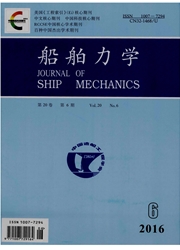

 中文摘要:
中文摘要:
水中张力生产平台(STLP)是一种新概念超深海油气开发装置,实现了浅水采油装备的超深海作业。柔性跨接管解耦了浮动式海洋平台运动与STLP的直接作用。尽管柔性跨接管的解耦效应已在一定程度得到证实,但是其对刚性立管系统的具体影响,仍然有许多问题存在。文章基于新概念水中张力平台,详细地探究了柔性跨接管对刚性立管系统整体特性的参数影响,阐述了STLP的基本工作原理与数值模拟方法。通过对STLP的刚性立管系统在不同海洋环境要素下的响应、干涉、强度、屈曲以及疲劳分析,对比探究了柔性跨接管对刚性立管系统的具体影响。特别地,文中亦探究了浮动式海洋平台的不同偏移参数的影响。该文研究所得的结论对于自站式混合立管的工程设计和分析具有广泛适用性。
 英文摘要:
英文摘要:
The Subsurface Tension Leg Platform(STLP) concept is considered as a competitive alternative system to support lower-rated well completion equipment and rigid risers in ultra-deep water for offshore petroleum production. Flexible jumpers connecting the vessel to the STLP effectively isolates the dynamic vessel motions from the rigid risers. Though the decoupled effect from flexible jumpers was confirmed to some extent, many problems still remain on the detailed influence of flexible jumpers. This paper details the results of a study to investigate the effects of flexible jumpers on the global behavior of the rigid riser based on STLP concept. A general description of STLP/Flexible jumper configuration as well as the numerical modeling methodology is introduced. The comparison results, such as riser global response, riser interference, riser's strength, buckling as well as fatigue performance, in relation to STLP with and without flexible jumpers under the excitations of currents, random waves and vessel motions are presented and discussed in detail. The effect of different vessel offset directions on the global behavior of the rigid riser is also considered. The obtained conclusions have wide ranging applicability in reference to the engineering design and analysis aspects of deepwater free standing hybrid riser concepts.
 同期刊论文项目
同期刊论文项目
 同项目期刊论文
同项目期刊论文
 Nonlinear lifting theory for unsteady WIG in proximity to incident water waves. Part 1: Two-dimensio
Nonlinear lifting theory for unsteady WIG in proximity to incident water waves. Part 1: Two-dimensio A numerical study of whole ship structural damage resulting from close-in underwater explosion shock
A numerical study of whole ship structural damage resulting from close-in underwater explosion shock Active Thermometry Based DS18B20 Temperature Sensor Network for Offshore Pipeline Scour Monitoring U
Active Thermometry Based DS18B20 Temperature Sensor Network for Offshore Pipeline Scour Monitoring U Experimental investigation of the interaction of multidirectional irregular waves with a large cylin
Experimental investigation of the interaction of multidirectional irregular waves with a large cylin Time-domain numerical and experimental analysis of hydroelastic response of a very large floating st
Time-domain numerical and experimental analysis of hydroelastic response of a very large floating st Research of concrete residual strains monitoring based on WLI and FBG following exposure to freeze-t
Research of concrete residual strains monitoring based on WLI and FBG following exposure to freeze-t Numerical studies on sloshing in rectangular tanks using a tree-based adaptive solver and experiment
Numerical studies on sloshing in rectangular tanks using a tree-based adaptive solver and experiment Numerical and experimental analysis of hydroelastic response on a very large floating structure edge
Numerical and experimental analysis of hydroelastic response on a very large floating structure edge Development of a regional coastal management decision-aided system. Part A: Establishment of an auto
Development of a regional coastal management decision-aided system. Part A: Establishment of an auto Vortex shedding from a two-dimensional cylinder beneath a rigid wall and a free surface according to
Vortex shedding from a two-dimensional cylinder beneath a rigid wall and a free surface according to Nonlinear lifting theory for unsteady WIG in proximity to incident water waves. Part 2: Three-dimens
Nonlinear lifting theory for unsteady WIG in proximity to incident water waves. Part 2: Three-dimens Second-order coupling of numerical and physical wave tanks for 2D irregular waves. Part II: Experime
Second-order coupling of numerical and physical wave tanks for 2D irregular waves. Part II: Experime Direct Time Domain Numerical Analysis of Transient Behavior of a VLFS during Unsteady External Loads
Direct Time Domain Numerical Analysis of Transient Behavior of a VLFS during Unsteady External Loads Coupled wind-wave time domain analysis of floating offshore wind turbine based on Computational Flui
Coupled wind-wave time domain analysis of floating offshore wind turbine based on Computational Flui Thickness distribution and extent of sea ice and snow in Prydz Bay and surrounding waters observed i
Thickness distribution and extent of sea ice and snow in Prydz Bay and surrounding waters observed i Application of support vector machine for pattern classification of active thermometry-based pipelin
Application of support vector machine for pattern classification of active thermometry-based pipelin Coupled control of the horizontal and vertical plane motions of a semi-submersible platform by a dyn
Coupled control of the horizontal and vertical plane motions of a semi-submersible platform by a dyn BP neural network recognition algorithm for scour monitoring of subsea pipelines based on active the
BP neural network recognition algorithm for scour monitoring of subsea pipelines based on active the Second-order coupling of numerical and physical wave tanks for 2D irregular waves. Part I: Formulati
Second-order coupling of numerical and physical wave tanks for 2D irregular waves. Part I: Formulati Numerical study of transient harbor resonance induced by solitary waves resonance induced by solitar
Numerical study of transient harbor resonance induced by solitary waves resonance induced by solitar 期刊信息
期刊信息
